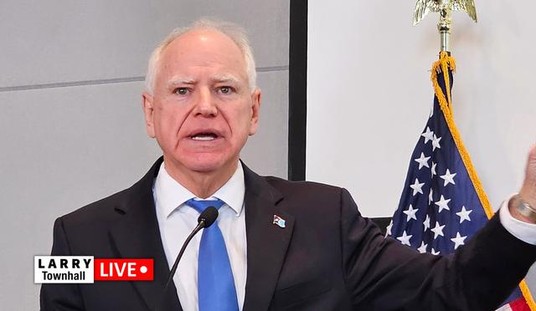Republicans and conservatives have correctly asserted that the federal government doesn’t have a revenue problem; it has a spending problem. However, a more trenchant summation of our public policy vices would go something like this: we don’t have a spending problem, per se; we have a big government problem.
While such a characterization might sound redundant, the Orwellian language used to describe spending cuts throughout the debt ceiling debate exposes a huge bifurcation between “spending cuts” and government reduction. The very same politicians who increased the debt $3.7 trillion in just two and a half years, and have condemned us to a future trajectory of $10 trillion more over the next ten years, are now tossing out spending cut bids to the tune of trillions, as if we were sitting at a Barney Frank foreclosure auction. Obama and the Democrats promote numbers like $4 trillion in cuts; no, $6 trillion; the Gangters of Six are staking their claim on $3.7 trillion. Finally, we are all told that, at the very least, there is consensus around $1.5 trillion in cuts from the Biden bunch.
So how can the very people who increased spending by trillions just last year suddenly exhibit such gaiety in cutting spending?
As we have seen from the Gangrene proposal, these “spending cuts” – to the tune of $2.7 trillion – will magically materialize, without eliminating a single agency or department from discretionary spending, or a single welfare program on the mandatory side. The only definitive and consequential cuts will be incurred by the military. Even after the most unprecedented era of prodigal spending that added $3.7 trillion in real debt, the Gangrene proposal would use phony and conflicting baselines to save $3.7 trillion over ten years, even while concurrently adding trillions more in debt.
The Gang plan, as well as every other negotiated proposal, achieves these spending cuts through slowing the rate of “straw men” baseline projections of growth. Even the caps on rate growth might not take effect until closer to 2015. Hence, we have spending cuts without downsizing one iota of government, along with all its pernicious effects on the private sector.
Accordingly, Republicans must not agree to any deal that does not offer real cuts; cuts that would eliminate government agencies and programs, while transforming the big entitlements through private or free market reforms. The appalling thing about the current debate is that everyone is focused upon Republican opposition to tax increases, while ignoring the fact that leadership would acquiesce to a deal which offers no real cuts – again, cuts that would actually downsize government.
Karl Rove and others are advocating that Republicans opt for a short-term debt limit increase of roughly $1 trillion, in exchange for Biden’s $1.5 trillion in “consensus” cuts. John Boehner said today that he has prepared members for a compromise and that Jim Jordan’s plan to hold the line does not reflect “anywhere close to a majority” of the conference. But what compromise? This dollar for dollar scheme sounds good. I might even support it if the trillion in cuts came from Obamacare or other big government time bombs. But again, these proposals do not reflect real cuts. We would be authorizing one dollar in real debt for the stratagem of future baseline cuts, all the while, failing to eliminate one penny from the $3.7 trillion Obama legacy, and worse, adding trillions in news spending.
In a post last week, I detailed the estimated federal government outlays for FY 2011, broken down by expenditure. Any deal that fails to extirpate significant sums from those numbers is a deal that contains zero cuts. Keep in mind that current spending levels include the outrageous government growth of the Obama administration that has added $3.7 trillion in deficits. Additionally, these numbers, for the most part, don’t even include the effects of Dodd-Frank and Obamacare.
If Republicans can’t stick by their pledge to countermand all post-2008 (or even post-2006) government increases (including Obamacare), as promised in the Ryan budget, then they will never cut spending or limit government.
If we can’t categorically abrogate Obama’s new government growth that is extremely unpopular, how will we limit parts of government that are 30-50 years old and quite popular with the public?
If Republicans fear the debt limit deadline enough to cave on the Ryan budget blueprint, does anyone really think they will rally behind the fundamentals of the Ryan budget for FY 2012 as the clock strikes midnight October 1? Republicans feared a government shutdown in April, they fear it in August, and they will do so in October – if nothing changes.
Republicans have worked diligently through the 12 annual appropriation bills for FY 2012. Following the adoption of the budget resolution on April 15, the exact date prescribed in the ’74 budget law, the House has already passed five spending bills, even though they were debated under an ‘open rule’, allowing a cumbersome and time-consuming process of unlimited amendments. The other spending bills have worked their way through committee and will be brought to the floor soon. Many of these bills contain real cuts in departments and agencies, as well as policy riders that would seriously limit their officious mandates on the private sector. Although conservatives would have liked to see sharper cuts in some of these bills; nonetheless, leadership is proceeding with the process of passing the Ryan budget.
Unfortunately, there is one big problem; the Senate. While the House is more than halfway through the budget process, Harry Reid’s impotent do-nothing Senate has not passed a budget in 813 days. As such, with the possible exception of the MilCon/VA bill, the Senate will not pass a single appropriations bill, thereby rendering all the House bills irrelevant. The entire 2012 budget, along with the thousands of policy riders and agency cuts, will hinge upon the next great battle; the omnibus or continuing resolution that will inevitably come forth in September.
Turning the clock ahead to late September, Obama and the Democrats will begin the same process of offering trillions upon trillions in unicorn cuts. Unless the GOP holds the line on all the salient policy riders, such as repeal of Obamacare, and real cuts in current discretionary spending, such as drastic reductions in the EPA and NLRB, all of those meritorious details of the Ryan budget will be moot. We will once again be debating a false choice between trillions in “spending cuts” and the possibility of “increases in revenue.” Throughout such a fiasco we will be abdicating our responsibility to offer authentic cuts to current levels of government.
That is our predicament for late September with the FY 2012 budget; that is our predicament now with the debt ceiling. Whether we make a short-term deal with the Democrats or a long-term deal; whether we agree to compromise “revenue increases,” or “tax reform,” the result would be the same. We would not have reduced the size of government, even from its current unsustainable level.
As game time approaches for budget negotiations, Republicans must also remember that the same way you could have trillions upon trillion in so-called spending cuts without reducing the size of government, you could also cut a few billion in spending – and drastically reduce government, while boosting economic growth. In other words, not all spending cuts are equal. The EPA, for example, only eats up about $10 billion a year, a paltry sum relative to other major expenditures. However, that $10 billion in direct taxpayer support is used to promulgate laws and regulations that remove hundreds of billions from taxpayers in the form of lower wages, costlier products, and market distortions. These government agencies, programs, and mandates also destroy hundreds of thousands of jobs. The same thing applies to the NLRB and many agencies within the Department of Energy and Interior. The cost of Obamacare is incalculable. And the TSA… In that sense, we link the debt crisis to the jobs crisis; we identify the problem as a big and overbearing government crisis.
Republicans need to hold the line on their own budget, which unlike any of the proposed compromises, actually cuts real discretionary spending, welfare and mandatory programs, eliminates Obamacare, and imposes free market reform on entitlements. If they hold the line on the size of government, the spending problem will summarily dissipate.
The federal government is too big to succeed; the private sector is too big to fail. Trillions in aimless cuts that defy basic arithmetic will not change the calculus of our big government problem. Don’t get caught up in the red herring tax issues and faux spending cuts.
Hold the freaking line on your own campaign promises and budget plan.













Join the conversation as a VIP Member